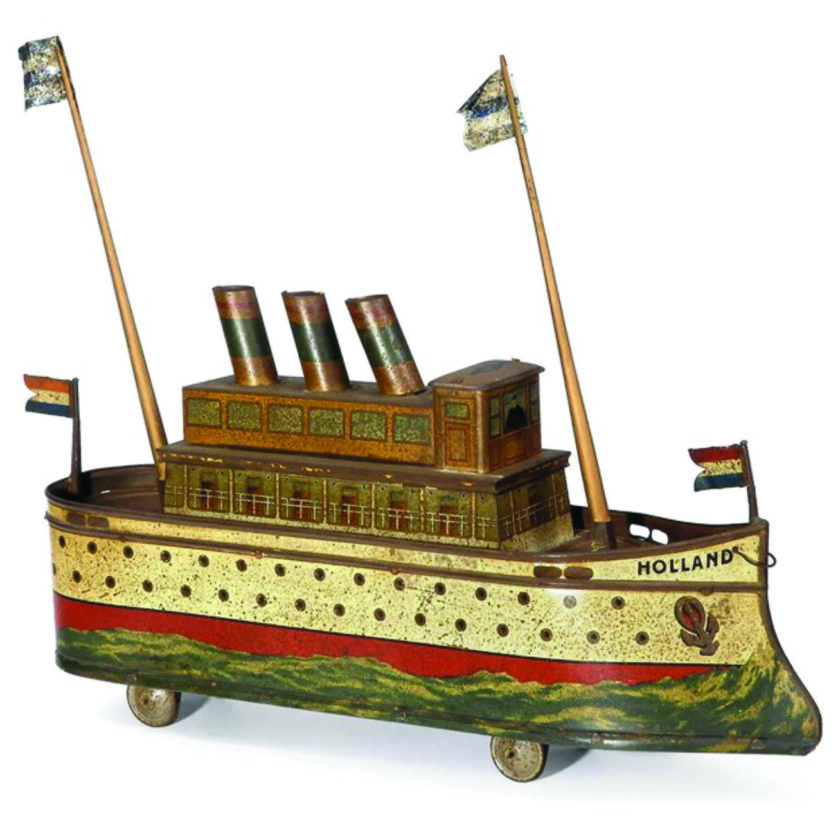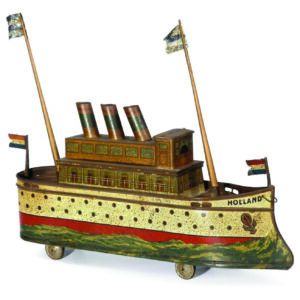Old tin toys sometimes doubled as food packaging

Biscuit tins, first made about 1830, were some of the earliest commercial food packages. The first tin toys were made about the same time. It wasn’t too long before clever designers found ways to combine the two. Tin packaging with colorful images always caught customers’ attention, and, while fashionable art styles and scenes of foreign countries appealed to adults, children were drawn to tins shaped and decorated like their favorite playthings.
In the late 19th to early 20th centuries, many companies packaged their products in tins shaped like buildings, vehicles, animals, and human figures. Some packages had moving parts, just like the mechanical tin toys of the time.
This biscuit (cookie) tin, made by Dutch company J. Bekkers & Zoon about 1920, is shaped like a steamboat marked “Holland,” complete with stacks, flags on masts, and lithographed details on the decks. The upper deck opens. It was evidently intended to double as a toy; there are runners on the base, so a child could push it along the floor and pretend it was on the water. It even has a lithographed wave for added realism. Tin toys and tin packaging are both highly collectible today. This tin, which fits both categories, sold for about $935 at an auction by the German company Auction Team Breker.
——
Q: I have inherited two autographed pictures of former President Harry S. Truman. One is in glass and the other is not. President Truman offered to sign these pictures for my cousin, who was a friend of his. They were signed after President Truman left office. Both pictures are in good shape. The one in glass measures 26 x 21 inches inside a 43 x 33-inch frame. The one without glass measures 21 1/2 x 25 1/2 inches in a 25 x 31 1/2-inch frame and is signed on the back. What is the best way to sell these pictures other than eBay?
A: There are several ways to sell autographed materials. Antiquarian book dealers sell them. So do some coin or stamp dealers. They also sell at general antique stores and auctions. Look for a dealer in your area. If you cannot find an appropriate one, you may want to contact an out-of-town dealer or auction house that specializes in historical materials; paper collectibles like photographs, prints, and books; or political collectibles. Autographed pictures of President Truman have sold for about $150 to $300 at recent auctions.
——
Q: I have many items from an estate, like plates, paintings, records, Hess trucks, and Hummels, and I don’t know what to do with them. How can I find a buyer?
A: Settling an estate is always a daunting task. There are many ways to sell collections, such as through a liquidator; with a house or garage sale; taking your items to a consignment shop; or selling them online. If you have some valuable items or a large specialized collection, you may want to contact an auction house or antiques dealer. For example, Hess trucks from the 1960s in good condition, and with their original packaging, can sell for hundreds, even thousands of dollars. If you have any, you may want to contact a dealer or auction house specializing in toys.
Individual Hummel figurines usually sell for low prices unless they are very early (crown or full bee mark), very rare, or unusual, such as international or jumbo figurines. A local library or art museum may have access to databases where you can look up the values of your paintings. If you cannot identify the artists, a museum or art gallery may be able to help you. There are websites like Discogs (discogs.com), Goldmine Magazine (goldminemag.com), and Money Music (moneymusic.com) where you can look up the values of your records.
You can also contact collectors’ clubs to find out more about your collections, connect with potential buyers or dealers, or find out about shows or other opportunities to sell. Kovels.com and AntiqueTrader.com have more articles with detailed information on selling collections, as well as directories where you can look up relevant businesses and clubs.
Remember, if you decide to do business with an auction house, consignment store, dealer, auction house, or anyone else, do your research and take precautions. Get references and reviews, make sure you know about any fees, and always get a signed copy of any agreement.
——
TIP: To clean a tin toy, first dust it. If it’s dirty, use soap and a little water to wash it. Be sure it’s completely dry before storing, and store it in a dry place, not in the basement.

